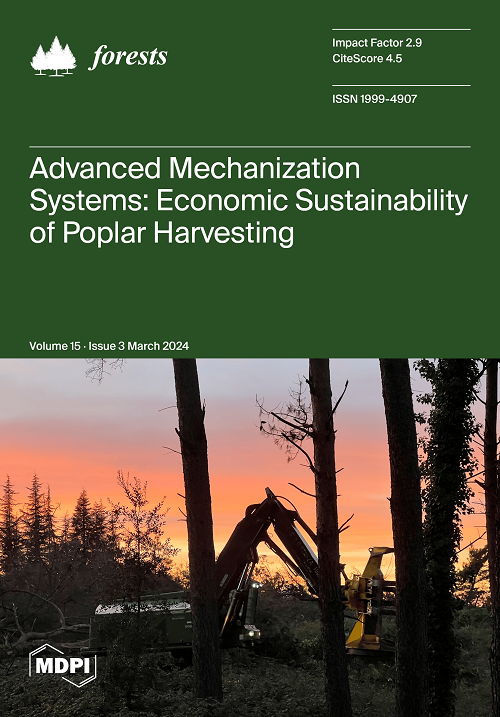竹子(Phyllostachys pubescens)的膨胀行为
IF 2.5
2区 农林科学
Q1 FORESTRY
引用次数: 0
摘要
竹子是一种用途广泛的植物。作为一种具有良好机械性能的天然可再生材料,它似乎是木材的一种有趣的替代品,而木材已成为一种稀缺而昂贵的商品。然而,要最大限度地发挥竹子在各种工业用途中的潜力,就必须全面了解竹子的特性。竹子的膨胀行为是尚未得到充分研究的特性之一。因此,在这项研究中,我们旨在测量和分析竹块的膨胀压力和动力学。结果表明,与木材类似,竹子的膨胀动力学也取决于其密度:组织密度越大,记录到的最大膨胀值越高。测得的最大切向膨胀率约为 5%-6%,低于最常用木材的数值。膨胀压力从 1.16 兆帕到 1.39 兆帕不等,取决于竹子的密度:样品密度越大,达到最大膨胀压力所需的时间越短。与木材一样,在纵向观察到的因膨胀而导致的尺寸线性增长最小(0.71%)。然而,与木材相反,径向膨胀(超过 7%)比切向膨胀(接近 6%)更明显。结果表明,竹子的膨胀特性使其成为在湿度变化条件下使用的良好材料,比许多树种的未改性木材更为有利。本文章由计算机程序翻译,如有差异,请以英文原文为准。
Swelling Behaviour of Bamboo (Phyllostachys pubescens)
Bamboo is a plant with various applications. As a natural, renewable material that exhibits good mechanical performance, it seems to be an interesting alternative to wood, which has become a scarce and expensive commodity. However, comprehensive knowledge of its properties is necessary to maximise its potential for various industrial purposes. The swelling behaviour of bamboo is one of the features that has not yet been sufficiently investigated. Therefore, in this research, we aimed to measure and analyse the swelling pressure and kinetics of bamboo blocks. The results show that similar to wood, the swelling kinetics of bamboo depend on its density: the denser the tissue, the higher the maximum swelling value recorded. The maximum tangential swelling measured was about 5%–6%, which is lower than the value for the most commonly used wood species. Swelling pressure ranged from 1.16 MPa to 1.39 MPa, depending on the bamboo density: the denser the sample, the shorter the time required to reach maximum swelling pressure. Like in wood, the smallest linear increase in size due to swelling was observed in the longitudinal direction (0.71%). However, opposite to wood, more pronounced swelling was recorded in the radial direction (over 7%) than in the tangential direction (nearly 6%). The results show that bamboo’s swelling behaviour makes it a good material for use in variable humidity conditions, being more favourable than the unmodified wood of many species.
求助全文
通过发布文献求助,成功后即可免费获取论文全文。
去求助
来源期刊

Forests
FORESTRY-
CiteScore
4.40
自引率
17.20%
发文量
1823
审稿时长
19.02 days
期刊介绍:
Forests (ISSN 1999-4907) is an international and cross-disciplinary scholarly journal of forestry and forest ecology. It publishes research papers, short communications and review papers. There is no restriction on the length of the papers. Our aim is to encourage scientists to publish their experimental and theoretical research in as much detail as possible. Full experimental and/or methodical details must be provided for research articles.
 求助内容:
求助内容: 应助结果提醒方式:
应助结果提醒方式:


